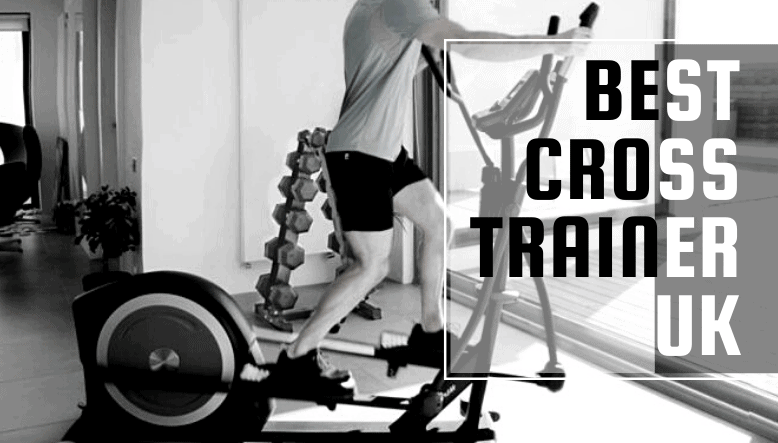
If you know you’re in the market for a cross trainer, please head straight down to our cross trainer reviews. If you want to know a bit more about cross trainers before you choose one, please head on down to our cross trainer buyer’s guide. If you want to know whether or not a cross trainer is the best choice for you, then please keep reading.
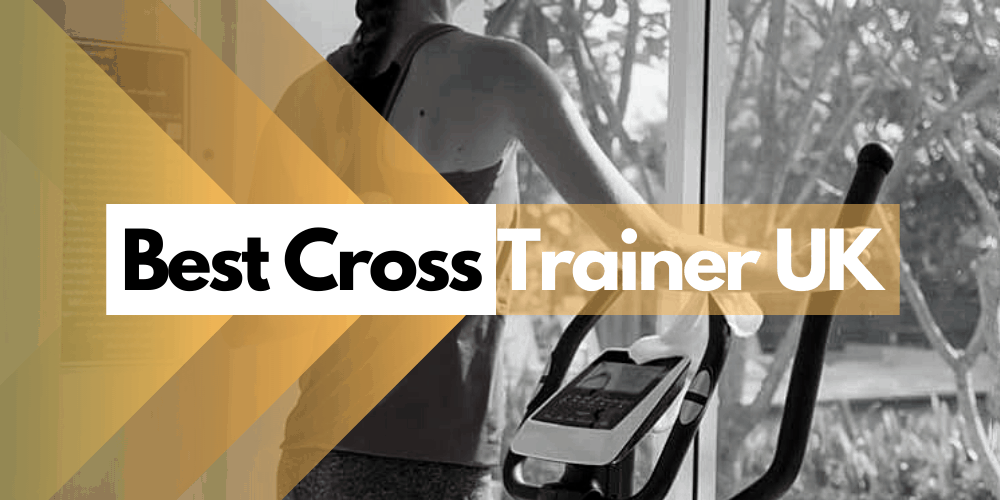
Is a cross trainer right for you?
Cross trainers have two big selling points. Firstly, they’re very safe to use. The fact that your feet stay on long, broad pedals means that there’s zero impact on your joints. It also means that it’s almost impossible to fall off. Secondly, cross trainers work out the whole body, so they make the most of your workout time.
On the other hand, cross trainers are fairly bulky, not the easiest items to store and relatively expensive. Realistically, anything you can do with a cross trainer, you can almost certainly do with other exercise equipment. It might not be quite as safe or convenient. It will, however, probably be both more compact and more affordable.
Siting and storing a cross trainer
When you’re thinking about how much space you’ll need for a cross trainer, you need to account for clear space around and above the cross trainer as well as the dimensions of the cross trainer itself. As a guideline, we’d suggest leaving a metre of clear space all around your cross trainer. How much vertical space you need will depend on how tall you are.
Ideally, your cross trainer should go in the main part of your house to make sure that it stays warm and hence dry. If your workout space is (mostly) unheated, then damp could become an issue. Moisture-damage is unlikely to be covered by your warranty. In fact, it could invalidate it.
If you really want a cross trainer and have to use an unheated workout space, then make sure that your cross trainer is covered appropriately out of use. You may not be able to buy a cover ready-made. It should, however, be fairly easy to make one or have one made for you.
As a final point, if you have a chain-driven cross trainer, then be aware that they are quiet rather than silent. They’re certainly loud enough to disturb someone in the same room. If you live in a flat, your neighbours might not be thrilled either. If you do opt for a chain-driven cross trainer, then you might want to put it on a rubber mat and ideally put that on top of carpet.
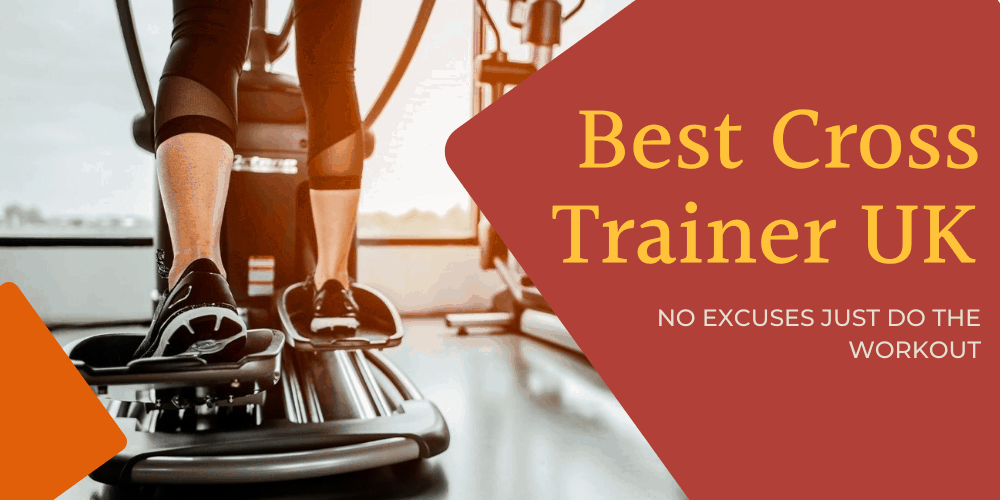
Cross trainer buyer’s guide
The five most important features on a cross trainer are the build quality, the overall size and stride length, the paddles and handlebars, the flywheel and the resistance. Serious users should also check out the console and might want to look at incline support. Here’s a quick guide to what you need to know.
Build quality
This one is fairly simple. The more regularly and vigorously you want to use your cross trainer, the more robust it will have to be to cope. This will be reflected in the price you pay so it’s important to be realistic about how you plan to use your cross trainer.
In simple terms, the lowest-priced cross trainers only tend to be suitable for occasional and/or light use. If you try to use them for regular, serious training, you’ll quickly get frustrated and probably break them.
Size and stride length
If you’re really short on floor space, then a cross trainer might not be the best option for you, especially not if you’re tall. The reason for this is that on cross trainers, there’s a direct link between the length of the cross trainer and the stride length.
The stride length is the distance between the front of your rear foot and the rear of your front foot. Smaller people naturally take shorter steps and hence can comfortably use shorter stride lengths even for vigorous exercise.
Taller people, by contrast, will naturally take longer steps. They can adapt to shorter stride lengths, but will probably find them constraining. This means that, in practical terms, they’ll only be able to use shorter stride decks for light, perhaps moderate, exercise. For anything more serious, they’ll need a longer stride deck and the floor space to accommodate it.
The paddles and handlebars
Paddles and handlebars can make a lot of difference to how comfortable and secure you feel. Ideally, you want two sets of handlebars. These are often described as “fixed bars” and “stride bars”. The fixed bars are there to help users who need help to balance or who just want to rest their arms. The stride bars are moveable and are used to work out your upper body.
For completeness, stride bars often come with pulse monitors. Unless you are spending big on a premium model, you generally want to take their readings with at least a moderate helping of salt. If you’re on a tight budget and really want accurate pulse readings, then invest in a separate heart-rate monitor.
The flywheel
The flywheel is literally what drives the cross trainer.
Front flywheels
The main advantages of a front flywheel are stability and effective folding. Having the flywheel at the front means that its weight is counterbalanced by the user’s weight at the back. It also means that the back half of the cross trainer can be folded upwards, like the deck on a treadmill.
On the minus side, having the flywheel at the front limits the length of the stride deck. It also means that users can end up tilting themselves forwards. This can be an issue for taller people and/or people who suffer from back pain.
The main advantage of a rear flywheel is that it allows for more space in the centre of the cross trainer. This means that the stride length can be longer. Technically, rear flywheels are less stable than front flywheels, but this issue can be easily addressed by adding wide supporting legs.
In practical terms, the real downside to rear flywheels is that they make it impossible to fold up a cross trainer in the same way as you fold up the deck on a treadmill. You can sometimes fold back the handlebars to save on vertical space. For many people, however, this is much less of an issue than saving floor space.
If you buy a new cross trainer from a mainstream retailer, you can generally assume that it has a bidirectional flywheel. This means that you'll be able to paddle both forwards and backwards. Bidirectional flywheels can really help you to add variety to your workout. If you’re buying from a niche source and/or pre-loved, then you might want to double-check this.
Flywheel weight
Realistically, you need a minimum weight of 5Kg for light-to-moderate exercise. The heavier the flywheel, the tougher you can make your workout if you choose. That said, even lighter flywheels can still give you a very decent workout if you turn the resistance up high enough.
Flywheel drive
Entry-level cross trainers may still use chain drives. As their name suggests, these are made of metal. This means that they are robust but relatively noisy. Belt drives are now more common even on budget cross trainers. These are silent but less robust. This means that you’ll need to replace them from time to time.
Resistance
Instead of getting hung up on the technicalities of resistance, look for the answers to two questions. Firstly, how many levels of resistance are there? Secondly, how do you change the resistance?
There are two main options for changing resistance. One is manually, usually by means of a knob on the central pole. The other is electronically, via the console.
Adjusting the resistance manually generally offers less scope for fine-tuning settings. It does, however, mean that the effect is almost instant. Adjusting the resistance electronically allows you to be more precise, but there is a slight delay while instructions are communicated.
The console
Even an entry-level cross trainer will generally have some sort of LCD display with basic performance statistics. As you go up the price points, you can get bigger and better screens with more information and the ability to display pre-set programs. If you’re on a tight budget but still want to track your performance accurately, you can invest in a separate fitness tracker.
Incline support
Incline support on cross trainers has much the same benefits as incline support on treadmills. It gives you more flexibility to vary the intensity of your workout and the muscles you target. It is, however, a lot more of a challenge to implement incline support on a cross trainer than it is on a treadmill. For this reason, incline support is usually reserved for super-premium cross trainers.
It’s also worth noting that manual incline support means that you need to get off the machine to adjust the incline. This can break the rhythm of your workout. Powered incline support, by contrast, requires a motor, which means noise.

Cross trainer reviews
Check out the “best budget cross trainer” section if you want a cross trainer for light/occasional use and/or are watching your pennies. Check out the “best home cross trainer” section if you want a cross trainer for heavier use, but still want a good deal. We’ve also included our “best 2-in-1” cross trainer for people who’re short on space but still want decent exercise.
Best budget cross trainer
XS Sports Luna Pro

This is billed as a “2-in-1” machine. Basically, this means that there’s a saddle, so, in theory, this machine can do double-duty as an exercise bike. Frankly, we’re not convinced. The pedals aren’t the right shape for cycling and there’s no way to strap in your foot. What’s more, in the cycling position, the handlebars are the wrong shape in and in the wrong place.
Ignoring the exercise bike function, however, this machine has a lot to be said for it just as a basic cross trainer. It has a short stride length, but that’s par for the course at this price point. Overall build quality is decent. There’s metal where it matters and while there’s certainly a lot of plastic it seems robust enough. We can see this cross trainer lasting a decent length of time.
Putting it together isn’t the most fun in the world. Overall we’d say watch some online demos first, then use the instructions as a backup. Getting it right matters because it influences the stability (or otherwise) of the cross trainer. Assuming you put it together correctly, this is impressively stable. The (chain-driven) front flywheel probably helps with this.
Overall, we’d say that the XS Sports Luna Pro is a bit misnamed. It’s definitely not pro. It is, however, a great option for older people wanting gentler exercise. It’s also fine for beginners on a budget, although you’ll probably want to trade up at some point. It might be OK as a back-up for more experienced users, especially for people short on space.
PRODUCT FEATURE
- Dimensions 122 x 60 x 154 cm
- Weight 28Kg
- Max user weight 110Kg
- Stride length 30 cm
- Flywheel Front, chain, 5.5Kg
- Resistance Variable (no settings)
- LCD shows distance, time, speed, calorie guide and pulse
Pros: Decent quality for the price, fairly portable, nicely stable
Cons: Exercise bike feature is pointless, not suitable for tall people, light flywheel
XS Sports Luna Pro 2-in1 Elliptical Cross Trainer Exercise Bike-Fitness Cardio Weightloss...
- XS Sports Pro Fitness Elliptical Cross Trainer with Pulse Sensors - 2 in 1 - Can Be Used As A Cross Trainer or Exercise Bike
- Front Mounted Flywheel for Added Stability - Adjustable Resistance for High & Low Intensity Workouts - Multi Function LCD Display: Pulse, Time, Speed, Distance, Calorie & Scan Mode
- XS Sports Pro Fitness Elliptical Cross Trainer with Pulse Sensors - 2 in 1 - Can Be Used As A Cross Trainer or Exercise Bike
- Front Mounted Flywheel for Added Stability - Adjustable Resistance for High & Low Intensity Workouts - Multi Function LCD Display: Pulse, Time, Speed, Distance, Calorie & Scan Mode
- Can Be Used to Workout Legs, Hips, Buttocks, Arms & Shoulders - Simulates Natural Walking Movements - Dual Direction Forward & Backward Elliptical Workout - Front Mounted Flywheel for Added Stability
- Steel Frame - Extra Wide Platform Pedals - Large Comfortable Seat - Front Wheels - Easy to Move Around the House - Max User Weight: 110kg - Max Foot Size: 12 (UK Size) - Size of Machine Foot Print Approx 91cm x 51cm - Some Assembly Required - Includes Full English Instruction Manual
- Moving Stride Bars for Upper Body Workouts - Fixed Bars with Pulse Sensors to Monitor Heart Rate During Workout - Total Body Low-Impact Cardiovascular Workout in the Comfort of Your Own Home
JLL® CT200 Home Cross Trainer
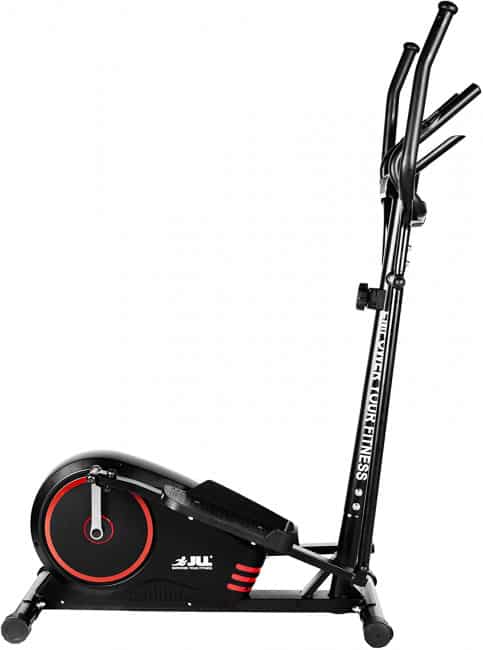
We were initially slightly concerned about the combination of a back flywheel and a light weight. Fortunately, however, this cross trainer is very stable. We’re guessing this is due to the wide supporting legs. The adjustable pedals probably help too.
The 30cm stride length might be a bit too small for the tallest people, but will be ample for most. We have to say, we appreciate the absence of a bike saddle. It just makes the cross trainer feel less crowded. We also like the fact that the flywheel is belt-driven as it means this cross trainer is practically silent.
The LCD is nice and clear, the console buttons respond well and the resistance is easy to adjust. We also really like the fact that there’s a tablet holder. We’re not quite convinced that this cross trainer is up to serious workout programmes. We can, however, see it being used while watching videos or, of course, playing music.
In short, there’s nothing spectacular about the JLL CT200, but what it does it does well. The build quality is very impressive for the price. As a bonus, this cross trainer is pretty easy to assemble. The JLL YouTube channel has a video walkthrough of how to do it. We’d suggest you watch this a few times and then instructions should make perfect sense.
PRODUCT FEATURE
- Dimensions 106.5 x 55.5 x 37 cm
- Weight 30.5Kg
- Max user weight 100kg
- Stride length 30cm
- Flywheel Back, belt, 5Kg
- Resistance 8 levels
- LCD shows time, speed, distance, calories burned, pulse & odometer
Pros: Excellent overall value, solid build quality, tablet holder
Cons: Light flywheel
JLL® CT200 Home Cross Trainer, 2020 Model, 8 Level Magnetic Resistance, Cardio...
- 8 Readout LCD Display Monitor:Time (mins:secs), Speed (km/h), Distance (km), Pulse (ppm), Calories & Odometer (km)
- Quiet Operation - 8 levels of magnetic resistance combined with belt driven technology provides the quietest and smoothest operation possible.
- 8 Readout LCD Display Monitor:Time (mins:secs), Speed (km/h), Distance (km), Pulse (ppm), Calories & Odometer (km)
- Quiet Operation - 8 levels of magnetic resistance combined with belt driven technology provides the quietest and smoothest operation possible.
- Transportable with front built in wheels; Maximum user weight: 100kg
- The flywheel provides a challenging yet smooth workout; operates in a two-way style so you can pedal forwards and backwards; dual action handlebars mean you can hold the stationary central handlebars or use the moving side swing bars; comfortable foam grips provide a comfortable workout. Advanced Momentum Mechanism to resemble 10kg
- Monitor can be used as a tablet holder (tablet not included); non-slip footplates provide maximum security while exercising; strong steel frame ensures grade A build quality. CE, UKCA & EN957 Standard Safety Compliant
- Maximum user weight: 100kg. CE, UKCA & EN957 Standard Safety Compliant
- Safety Information: Children under the age of 12 are prohibited from using this machine, those between 12yr-18yr are to be supervised at all times while in use.
- 1 Year Warranty for *home use only*
Best home cross trainer
Reebok ZR8 Cross Trainer

When it comes to fitness equipment, Reebok consistently hovers around the place where the top end of the budget range blends into the entry-level of the mid-price range. The Reebok ZR8 is a case in point. It’s also another example of Reebok doing what it does so well. In other words, this cross trainer sticks to the basics and implements them to a very high standard.
The most noticeable difference between the Reebok ZR8 and the other cross trainers in this round-up is that the stride length is 37.5cm. That’s enough for even taller people to make good use of the 9Kg flywheel, 32 levels of resistance and pre-set programmes.
We’re not going to sugar-coat the challenge of putting together the Reebok ZR8. Sadly, Reebok is notorious for its complicated builds. Fortunately, this plus the fact that its equipment is so popular means that there’s plenty of help online.
Once you have it together, you’ll be able to appreciate the solid build quality and focus on real-world use. For example, the weight of the back flywheel is effectively counterbalanced by the overall weight and the broad supporting legs. This ensures that the Reebok ZR8 is reassuringly stable, even if you’re taller or heavier.
Look a bit more closely and you’ll notice thoughtful touches such as cushioned, anti-slip foot paddles. You’ll also notice that the LCD screen is a whole lot bigger and better than anything you’ll see on most of the competition. Reebok is clearly expecting this cross trainer to be used by people who want their statistics and their pre-set programmes.
Overall, this cross trainer is the clear winner for anyone who wants to do serious cross training at home without busting their budget. It’s really the only budget-friendly cross trainer we can see standing up to the likes of HIIT, at least on a regular basis.
PRODUCT FEATURE
- Dimensions 144 x 63 x 169 cm
- Weight 50.8Kg
- Max user weight 120Kg
- Stride length 37.5 cm
- Flywheel Back, belt, 9Kg
- Resistance 32 levels
- LCD shows speed, distance, time, calories, pulse, watts and RPM + pre-set programmes
Pros: Cushioned footpads, suitable for larger users, pre-set programmes, hefty flywheel
Cons: Fairly heavy
Reebok ZR8 Cross Trainer
- The ZR8’s 9 kg flywheel weight ensures a challenging, smooth and quiet elliptical motion to give you a comfortable, fluid workout experience - ideal for those seeking a low impact form of exercise
- You can tailor the intensity of your workout, while you exercise, by selecting the desired resistance level via the console; there are 32 levels of electronic resistance for you to choose from
- The ZR8’s 9 kg flywheel weight ensures a challenging, smooth and quiet elliptical motion to give you a comfortable, fluid workout experience - ideal for those seeking a low impact form of exercise
- You can tailor the intensity of your workout, while you exercise, by selecting the desired resistance level via the console; there are 32 levels of electronic resistance for you to choose from
- To help keep you motivated, there are 20 fitness programs built into the console; designed by our Reebok master trainers to take you from a gentle exercise to a challenging mountainous hill climb
- The large backlit LCD screen provides the feedback you need to help improve your fitness level by tracking and displaying your progress; including speed, distance, time, calories, pulse, watts and RPM
- The cushioned footplates can be easily adjusted to suit your stride length while the dual-action and fixed handlebars have a soft, sweat-resistant surface so you can focus on your fitness
- Light enough to move around your home using the integrated transport wheels and solid enough to take a maximum user weight of 120 kg (approximately 18 stone) thanks to the ZR8’s premium build quality
- Comes with 2-year parts and labour warranty as standard; easy to follow assembly instructions and a dedicated Reebok UK helpline and online chat, should you need any assistance
JLL® CT300 Home Luxury Elliptical Cross Trainer
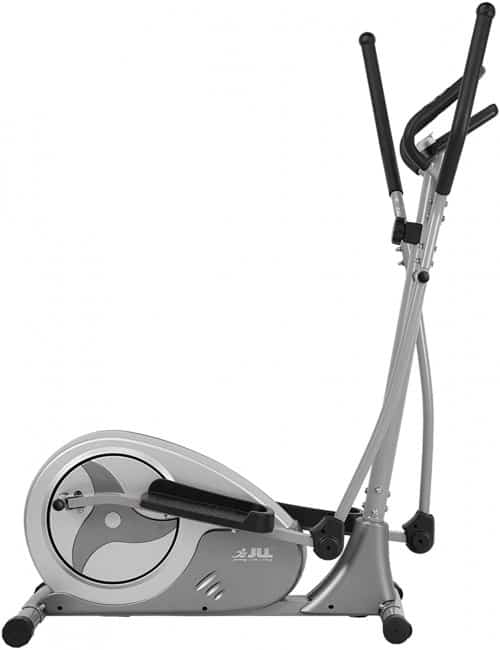
The JLL CT300 basically crosses the headline specs of the JLL CT200 with the build quality of the Reebok ZR8. Frankly, it looks better than either. In fact, this is the only cross trainer we’d be really happy to have permanently on display in a public room. More practically, it is super-comfortable and very easy to use.
At this price point, we’d have preferred a longer stride length and a heavier flywheel. We suspect, however, that the target market for this cross trainer is people who want a regular, light-to-moderate workout. If that’s you, then we can see you getting a lot of happy use out of this cross trainer.
PRODUCT FEATURE
- Dimensions 120 x 61 x 167 cm
- Weight 35.9 Kg
- Max user weight 100kg
- Stride length 28 cm
- Flywheel Back, belt, 5.5Kg
- Resistance 8 levels
- LCD shows speed, distance, time, temperature, heart rate, calories, body fat & pulse recovery
Pros: Excellent build quality, comfortable handlebars and pedals, quick resistance changes
Cons: Flywheel is on the lighter side, machine is fairly heavy, max user weight only 100Kg
JLL® CT300 Home Luxury Elliptical Cross Trainer, 2020 Magnetic Cardio Workout with...
- 8 Readout LCD Display Monitor: Displays Speed, Distance, Time, Temperature, Heart-Rate, Calories, Body Fat & Pulse Recovery.
- Quiet Operation - 8 levels of magnetic resistance combined with belt driven technology provides the quietest and smoothest operation possible.
- 8 Readout LCD Display Monitor: Displays Speed, Distance, Time, Temperature, Heart-Rate, Calories, Body Fat & Pulse Recovery.
- Quiet Operation - 8 levels of magnetic resistance combined with belt driven technology provides the quietest and smoothest operation possible.
- Transportable with front built in wheels; Maximum user weight: 100kg
- The flywheel provides a challenging yet smooth workout; operates in a two-way style so you can pedal forwards and backwards; dual action handlebars mean you can hold the stationary central handlebars or use the moving side swing bars; comfortable foam grips provide a comfortable workout. Advanced Momentum Mechanism to resemble 12kg
- Monitor can be used as a tablet holder (tablet not included); non-slip footplates provide maximum security while exercising; strong steel frame ensures grade A build quality.
- Safety Information: Children under the age of 12 are prohibited from using this machine, those between 12yr-18yr are to be supervised at all times while in use.
- 1 Year Warranty for *home use only*
Best 2-in-1 cross trainer
Limepeaks - LMP-1001
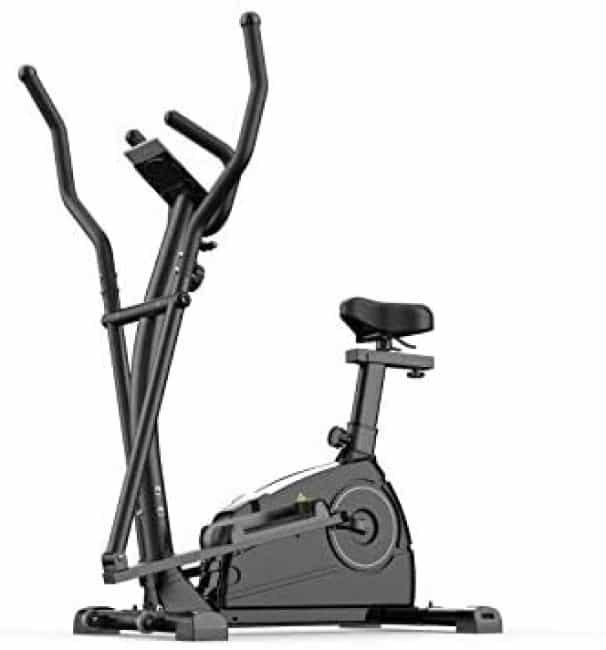
For clarity, you’re probably not going to save cash buying this in preference to a stand-alone cross trainer plus a stand-alone exercise bike. You’re definitely not going to get the same level of performance from the exercise bike function on this cross trainer as you would from a regular exercise bike.
You can, however, save yourself quite a bit of space with this 2-in-1 cross trainer. This means that it’s a great option for people who mainly want a cross trainer but would quite like to have a change from time to time.
We have the same issue with the pedals as we did with the XS Sports Luna Pro. They’re the wrong shape for cycling and there’s no way to strap in your foot. It’s a real shame that there doesn’t seem to be any way to swap these out. If there were, this 2-in-1 cross trainer would actually be a very decent option for both cross training and cycling.
The reason why this 2-in-1 cross trainer delivers a much better cycling experience is that the handlebars have been designed to accommodate both cycling and cross training. On the XS Sports Luna Pro, the fixed handlebars are vertical bars fitted tightly on either side of the console.
On the Limepeaks - LMP-1001 by contrast, the fixed handlebars are shaped like a more exaggerated version of the curved handlebars you’ll find on spin bikes (and some real bikes). There’s also much more room between the handlebars and the console. This means that, in our opinion, most people should be able to use the fixed bars comfortably from the saddle.
As you’d expect given the higher price, the overall build quality is a massive improvement over the XS Sports Luna Pro. In particular, it has a longer stride length and a heavier flywheel. It’s still nowhere near gym standard, but, it’s more than adequate for safe, comfortable home use on a regular basis.
PRODUCT FEATURE
- Dimensions 100 x 72 x 149 cm
- Weight 35Kg
- Max user weight 120Kg
- Stride length 35cm
- Flywheel Back, belt, 6Kg
- Resistance 8
- LCD shows speed, distance, time, odometer, calories, pulse
Pros: Exercise bike function is decent, build quality is excellent, saddle and handlebars are comfortable
Cons: No way to swap out the pedals for cycling, exercise bike performance is not as good as a proper exercise bike
Limepeaks - LMP-1001 (Black) Compact 2-In-1 Dual Action Indoor Elliptical Cross Trainer...
Best cross trainer UK
The XS Sports Luna Pro and the JLL CT200 both have a lot of limitations. If you’re only using them occasionally and/or for light training, they’re unlikely to bother you. If you want to get more serious, however, you’re going to need a better cross trainer.
The Reebok ZR8 and the JLL CT300 are both capable of standing up to more regular and more vigorous use. The Reebok ZR8 wins out on functionality (especially stride length) but the JLL CT300 wins out on looks and ease of use.
The Limepeaks - LMP-1001 is the best 2-in-1 cross trainer we’ve found. We still think you’d get a better overall deal with two separate machines. At the same time, we appreciate that for some people, that’s just not a practical option.
Katie is our resident Editor and extremely is a well-respected voice in the world of fitness. Katie has a first-class Hons degree in Journalism and is proud to say that she has written leading entries featured in the biggest media outlets including Vogue, Women Health Magazine and CoachMag. Great outdoors and animal lover and always on the go









































![Best Cross Trainer UK – [Expert Review Guide]](https://fitnessauthority.co.uk/wp-content/uploads/thumbs_dir/Affordable-Iron-Rich-Foods-For-Both-Meat-Lovers-Vegetarians1-e1602533524723-p5n527bokq910qr7pq3xwnw2zojac4dwaajk5fbxa4.png)
![Best Cross Trainer UK – [Expert Review Guide]](https://fitnessauthority.co.uk/wp-content/uploads/thumbs_dir/Best-Exercise-Bike-UK-Expert-Review-Guide--oyboot9heo7bgfm69j8zp770ftz2k9m2c44v9rybzw.png)









